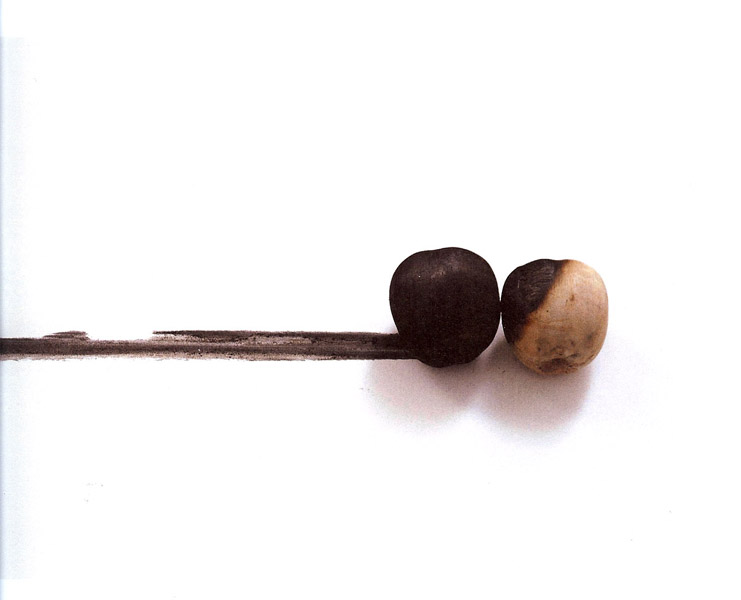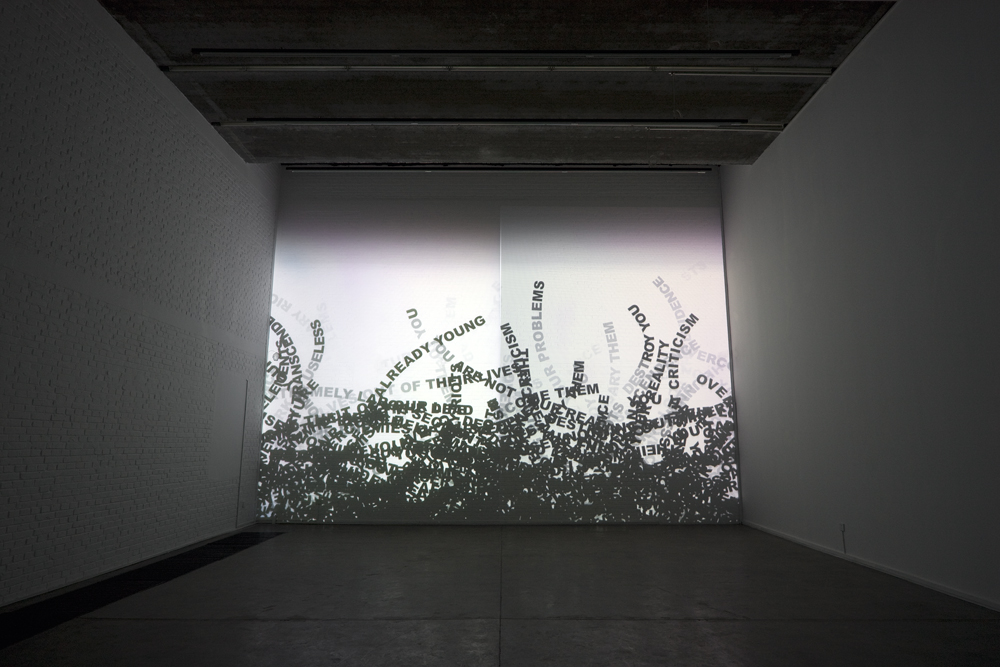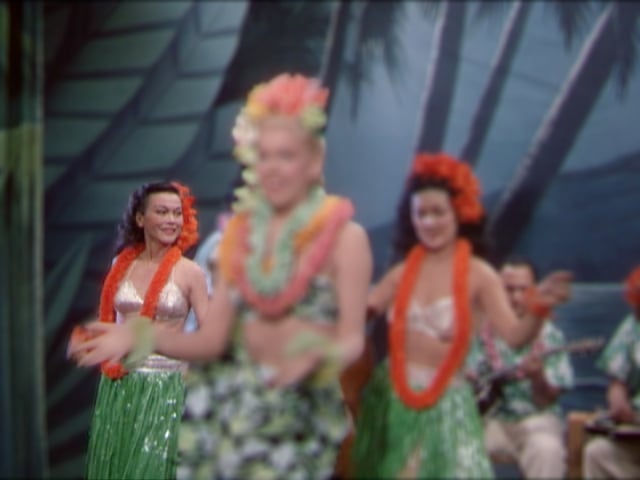
© » KADIST
Pichet Piaklin
The Wings by Pichet Piaklin is a creation story of fragility, where the desire for freedom is mired in blood red by the inculcation of faith and violence. Piaklin was born and continues to live and work in Thailand’s deep south, a geographical area once known as the Pattani Kingdom (now the Pattani, Yala, and Narathiwat provinces), before it was annexed by the Siam Kingdom in the early 1900s. As a consequence of unreconciled historical conflict, this predominantly Muslim community continues to endure oppressive social and political conditions under the ruling Thai Buddhist monarchy.

© » KADIST
Imran Qureshi
At first glance, This Day by Imran Qureshi appears to be an energetic, gestural painting reminiscent of Action Painting from the mid-20th century. But upon closer inspection, highly detailed floral elements reveal themselves amongst the bold red brushstrokes. The botanical motifs in Qureshi’s work represent life and regeneration while the red paint refers to death and mortality.

© » KADIST
Nidhal Chamekh
Drawing & Print (Drawing & Print)
Nidhal Chamekh made the first drawings of the ongoing series Mémoire Promise in 2013. In the series, the artist persistently dissects, examines and describes his experiences and memories of his family and life in Tunis, Tunisia. As underlined by poet Arafat Sadallah, the artist draws eyes and gazes of unachieved portraits, hands and arms of a skeleton—figures disappear but they witness and testify.

© » KADIST
Jean-Luc Moulène
Head Box by J ean-Luc Moulène i s not the representation of a space but a real space that remains in the domain of sculpture which the artist develops in parallel with his photographic practice. Created for an exhibition in Kitakyushu in Japan, it is painted green, a color that symbolizes life and creation in Japanese culture. Even though we are confronted with a hollow presence, this is above all a space to lodge a body in the vertical posture of the living.

© » KADIST
Jiri Kovanda
This ephemeral installation by Jirí Kovanda, documented in the same way as his performances with a photograph and a text, belongs to a body of works that took place in his apartment/studio. During an interview with Hans Ulrich Obrist, the artist highlighted that he had never had a studio and that this work space blended with his apartment. A piece of string cuts across the room in a diagonal; it functions as a scale to measure time and space.

© » KADIST
Mika Tajima
Mika Tajima’s Pranayama sculptures are built from carved wood and chromed Jacuzzi jets and are presented as artefacts. The title refers to the control of the breath, ‘prana’ in Ayurvedic practice, as the regulation of the vital life force. According to the artist, the sculptures, mediating between two spaces, serve “as membrane, portal or filter between the immediate and the beyond.

© » KADIST
Michel François
Drawing & Print (Drawing & Print)
In Michel François’s work, « it is the real, physical and emotional experience that stimulates creation which is therefore highly charged with a vital force. There lies also the profoundly and clandestine figurative nature of his work » (Guillaume Désanges). Contamination is a constant in Michel François’s work.

© » KADIST
David Horvitz
On March 30, 2015, at 5:52am, David Horvitz caught his daughter, Ela Melanie, as she was being born, in the back of an Uber driving through Midtown Manhattan. He held her up in the morning light as the car drove down Park Avenue, blocks away from the Museum of Modern Art, where Zanna Gilbert, the mother, was a fellow. After arriving at the hospital, Horvitz tweeted a photo and later e-mailed his friends and family with additional images.

© » KADIST
Yang Song
Yang Song’s Die features a clay mask of the artist himself slowly dissolving into water. Clay returns to clay. Clay originates from and returns to earth, becoming a metaphor for life.

© » KADIST
Julien Creuzet
Full title of the work: Grain par Grain, sur le parterre humide et fissuré. Érosion sévère, graine, ma cote. Où est la manne, semence de l’antiquité.

© » KADIST
Rodrigo Braga
Braga’s video work Provisão (2009) opens with a still shot of a clearing in a forest, shoots of grass emerging from a muddy brown patch of seemingly dry and barren earth. As the camera fades to black, the viewer hears the repeated sound of a shovel striking dirt. The camera fades back to the clearing and zooms in on a shirtless man digging up the ground.

© » KADIST
Ian Breakwell
“BC/AD” (Before Cancer, After Diagnoses) is a video of photographs of the artist’s face dating from early childhood to the month before he died, accompanied by the last diary entries he wrote from April 2004 to July 2005 (entitled “50 Reasons for Getting Out of Bed”), from the period from when he lost his voice, thinking he had laryngitis, through the moment he was diagnosed with lung cancer and the subsequent treatment that was ultimately, ineffective. The diary entries are at once poignant, ironic, laced with gallows of humor, with his continued eye for the little incidents in life, interweaving the past with his experience of the present. The morphing of the portraits—the eyes and sight remaining leveled—is haunting, beginning with very blurry images of childhood and ending with a pin-sharp photograph of Breakwell the month before he died.

© » KADIST
Rachel Rose
In the 2013 video work, Sitting Feeding Sleeping , Rose combines footage taken of zoo animals living in captivity with screen images that flicker and flash before us. In the narration, Rose talks about forms of life that are suspended and simulated—artificial intelligence and cryogenically frozen bodies, zoo animals and counterfeit ecologies. Through this montage of different types of footage and text, Rose poses us between the natural and the artificial, and speaks to the very strange moment of life in a world that is seemingly caught between the two, existing in a hybrid (though not necessarily symbiotic) moment of radical change.

© » KADIST
Will Rogan
Will Rogan’s video Eraser (2014) shows a hearse parked in a clearing amidst leaf barren trees. The steely grey sky stands in stark contrast to the vehicle’s luminously pristine white finish and makes this already deathly object seem even more ghostly. The grass underneath is half-turned brown and further marks this as a lifeless landscape.

© » KADIST
Miljohn Ruperto
Miljohn Ruperto’s high-definition video Janus takes its name from the two-faced Roman god of duality and transitions, of beginnings and endings, gates and doorways. He is usually depicted with two faces as he looks both forward and backward, to the future and the past. The video, which is deftly animated in collaboration with Aimée de Jongh, presents a close-up of a dying “duck-rabbit,” a vivified version of an ambiguous illustration made popular by the Austrian-British philosopher Ludwig Wittgenstein in his Philosophical Investigations .

© » KADIST
Tsang Kin-Wah
The Third Seal—They Are Already Old. They Don’t Need To Exist Anymore is part of The Seven Seals , Tsang’s ongoing series of digital videos that are projected as installations onto the walls and ceilings of dark rooms. Using texts and computer technology, the series draws its reference from various sources—the Bible, Judeo-Christian eschatology, existentialism, metaphysics, politics, among others—to articulate the world’s complexity and the dilemmas that people face while approaching “the end of the world.” The Third Seal is a nineteen-by-twenty-seven-foot projection on a single wall that, together with sound, creates an immersive and dynamic environment.
Mika Tajima
Japanese-American artist Mika Tajima creates sculptures, paintings, videos, and installations with a focus on techniques and technologies of control...
Yang Song
Yang Song was trained as a sculptor in both Western and Eastern traditions, which continue to influence his practice today...
Rachel Rose
Rachel Rose is a visual artist known for her video installations that merge moving images and sound within nuanced environments connecting them to broader subjects...
David Horvitz
Although the practice plays a central role in the work of David Horvitz, his work is at the opposite of fine art objects...
Jiri Kovanda
- location: Praha, Ceská Republika
- year born: 1953
- gender: male
- nationality: Czech
Pichet Piaklin
Pichet Piaklin is an artist and teacher, whose commitment and belief in art saw him establish the Faculty of Fine and Applied Arts at the Prince of Songkhla University in Pattani, in Thailand’s deep south...
Nidhal Chamekh
Based between his native Tunis and Paris, Nidhal Chamekh’s work is an investigation into history as a point of access to our contemporary times...
Will Rogan
- location: Albany, California
- year born: 1975
- gender: male
- nationality: American
Miljohn Ruperto
- location: Los Angeles, California
- year born: 1973
- gender: male
- nationality: Filipino and Danish
- home town: Manila, Philippines
Tsang Kin-Wah
- location: Hong Kong, China
- year born: 1976
- gender: male
- nationality: Chinese
- home town: Shantou, Guangdong Province, China
Julien Creuzet
The work of Julien Creuzet reveals painful stories – both personal and political – making it impossible separate one from the other...
Ian Breakwell
- location: Derby, United Kingdom
- year born: 1943
- gender: male
- nationality: British
Imran Qureshi
Pakistani artist Imran Qureshi’s practice revives 16th century Mughal miniature painting...
-
1970-1979
Jiri Kovanda
1979This ephemeral installation by Jirí Kovanda, documented in the same way as his performances with a photograph and a text, belongs to a body of works that took place in his apartment/studio...
-
2000-2009
Michel François
Drawing & Print
2004(Drawing & Print) In Michel François’s work, « it is the real, physical and emotional experience that stimulates creation which is therefore highly charged with a vital force...
Ian Breakwell
2008“BC/AD” (Before Cancer, After Diagnoses) is a video of photographs of the artist’s face dating from early childhood to the month before he died, accompanied by the last diary entries he wrote from April 2004 to July 2005 (entitled “50 Reasons for Getting Out of Bed”), from the period from when he lost his voice, thinking he had laryngitis, through the moment he was diagnosed with lung cancer and the subsequent treatment that was ultimately, ineffective...
Jean-Luc Moulène
2009Head Box by J ean-Luc Moulène i s not the representation of a space but a real space that remains in the domain of sculpture which the artist develops in parallel with his photographic practice...
Rodrigo Braga
2009Braga’s video work Provisão (2009) opens with a still shot of a clearing in a forest, shoots of grass emerging from a muddy brown patch of seemingly dry and barren earth...
-
2010-2019
Rachel Rose
2013In the 2013 video work, Sitting Feeding Sleeping , Rose combines footage taken of zoo animals living in captivity with screen images that flicker and flash before us...
Miljohn Ruperto
2013Miljohn Ruperto’s high-definition video Janus takes its name from the two-faced Roman god of duality and transitions, of beginnings and endings, gates and doorways...
Will Rogan
2014Will Rogan’s video Eraser (2014) shows a hearse parked in a clearing amidst leaf barren trees...
Nidhal Chamekh
Drawing & Print
2016(Drawing & Print) Nidhal Chamekh made the first drawings of the ongoing series Mémoire Promise in 2013...
Imran Qureshi
2017At first glance, This Day by Imran Qureshi appears to be an energetic, gestural painting reminiscent of Action Painting from the mid-20th century...
Mika Tajima
2017Mika Tajima’s Pranayama sculptures are built from carved wood and chromed Jacuzzi jets and are presented as artefacts...
-
2020-2029
Pichet Piaklin
2021The Wings by Pichet Piaklin is a creation story of fragility, where the desire for freedom is mired in blood red by the inculcation of faith and violence...
David Horvitz
2021On March 30, 2015, at 5:52am, David Horvitz caught his daughter, Ela Melanie, as she was being born, in the back of an Uber driving through Midtown Manhattan...



